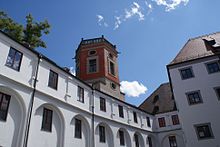Kastenturm (Augsburg)
The Kastenturm , also called Spitalturm , is a water tower in Augsburg and a monument to Augsburg's historical water management . It is located at the Heilig-Geist-Spital , which is adjacent to the waterworks at the Red Gate .
The base of the water tower is a late medieval defense tower, which Jakob Eschay raised by two hexagonal storeys in 1599 and converted into a water tower. Its roof end has been surrounded by a stone balustrade since 1703.
The double spiral staircase
On the sixth floor of the box tower, the Augsburg fountain master Caspar Walter built an unusual, solid wood, cuboid, double-barreled spiral staircase that he built himself. It bears his initials MCW and the year 1742. The central column of the spiral staircase has a spiral slot opening through its center, which allows two people who are simultaneously stepping up the two parts of the double spiral staircase to hold hands . The upper end of this column is adorned with a stone pine nut .
Since there was no practical need for a double-flight spiral staircase, it is believed that it was a showcase for the fountain master with whom he demonstrated his engineering skills. The spiral staircase is still in the box tower today.
The pool of water

The tower's water basin was on the top, seventh floor with the transverse oval windows. It was made as a hexagonal pool decorated with ornamental ornaments, which blended harmoniously into the hexagonal cross-section of the tower.
This basin no longer exists today.
The well youth
The box tower was artistically designed far beyond its pure functionality. The middle of the water basin was originally adorned by the late mannerist figure of the fountain youth created by Adriaen de Vries in 1601 , cast by Wolfgang Neidhardt , a so-called " plug figure ". The 63 cm high naked youth with a mustache, a triton , sits on a stone overgrown with grass and flowers and pours a steady stream of water from the house of a large sea snail into the basin.
The water from this basin then fed the three magnificent Augsburg fountains via pipes with the necessary pressure . Augsburg decorated the Kastenturm so lavishly that high-ranking visitors to the city, such as cardinals, princes, dukes and scholars, wanted to see the water art , which at that time was the pride of the free imperial city.
There is evidence that the youth well was installed in the box tower from 1602 to 1741. Caspar Walter had it removed from the tower in 1741 or 1746, probably as part of a general renovation of the box tower, and replaced it with a simpler tap. The fountain youth then served as part of a fountain in the Brunnenmeisterhof until it was brought to the Maximilian Museum in 1894 , where it is still located and can be viewed today. Originally golden in color, the bronze figure now has a gray-green patina.
literature
- Wilhelm Ruckdeschel: Industrial culture in Augsburg . Brigitte Settele Verlag, 2004, ISBN 3-932939-44-1 , p. 14th ff .
Individual evidence
- ^ Martin Kluger: Hydraulic engineering and hydropower, drinking water and fountain art in Augsburg . 1st edition. Context Verlag, Augsburg 2013, ISBN 978-3-939645-72-6 , p. 95 .
- ^ Martin Kluger: Historical water management and water art in Augsburg. Canal landscape, water towers, fountain art and water power . 2nd Edition. Context Verlag, Augsburg 2012, ISBN 978-3-939645-50-4 , p. 69 f .
Coordinates: 48 ° 21 ′ 37.3 " N , 10 ° 54 ′ 13.5" E




